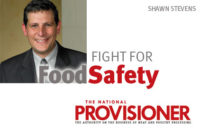Consultants Corner
How to handle a Food Safety Assessment (FSA)

It’s that time of the year (or every four years to be more exact). You get the warning from your inspector, or the call comes in directly from an EIAO; it’s time for your periodic Food Safety Assessment (FSA). They follow up with a letter in which you are told to provide 60 days of records, all of your supporting documents, include your HACCP Plans, SSOP, GMPs, scientific documents, etc., a place to work, access to your facility, to include a tour, etc.
The first thing you notice after the call is your IIC is a bit uptight. Truth be told, they don’t like FSAs any more than you do. The in-plant inspector’s job is to spot check. The EIAO is going to look at a solid 60 days (at a minimum) of history. Inevitably, your inspector thinks they have missed something and their goal is to find it before the EIAO arrives. So on top of going through a FSA, you have an in-plant inspector who is on edge. Sound familiar?
So how do you get through the FSA and its inevitable findings?
First off, know the EIAO is going to have a finding. You can pore over tons of FSAs, and while I don’t have the statistics, I would bet a steak dinner that less than 0.5 percent have no findings.
Secondly, you must stay calm, not just before they arrive, but during the entire process. I have seen it way too many times: Management gets overwhelmed with trying to maintain normal operations and cater to the EIAO, stress levels are high and the simple question isn’t answered, mistakes are made during the FSA, etc. Stay calm. The vast majority of FSAs end up with a few NRs, and even NOIEs aren’t the end of the world. More on that later.
The third thing that you must do is be organized. The last thing you want is for the EIAO to be constantly looking for something, to miss something or to spend extra time wandering around asking for documents. Your goal is to get them out of your facility as quickly as possible.
There are a lot of ways to organize your documents. The following suggestions assume the majority of your records are paper-based.
Give them data, organized
To start off, you want to have all of your programs and records ready for them before they arrive. As long as you have to put them together, take a bit of time and review them yourself. If you spot an issue, get ahead of it. Don’t hope they will miss it, because chances are they won’t. Deal with it beforehand.
An easy setup, if possible, is to have a banker’s box in which you can stand the records up and have them ready to go through. At a minimum, have two boxes — one for the programs, the other for the records. Another way is to have it so each program has its own box and you put the program in the front of the box and the records in the back. Again, the goal is to make it easy for them to correlate the record to the program and have it flow in order so that it all makes sense. Why make it easy? Because the faster they go through the plans and correlate them to the records, the faster they leave. The longer they are there, the more they will find wrong. A side benefit is that this approach also allows you to get at your plans quickly and easily if you need them.
When you pull the records, organize them by date and by category or topic, be it a HACCP cooking record, SSOP pre-op monitoring records, GMP record, etc. Have a file set up for pre-op records, organized by oldest to newest, and another for operational SSOP records, again organized oldest to newest. You want the records to be in the same order as your food-safety programs. The basic order is SSOP, GMP and other pre-requisites (don’t forget LM, SRM, recall and traceback) and finally HACCP plans, with the applicable validation.
The next thing you want to do is have your HACCP plans set up and ready to go. Use the same format for each of them. Start with the HACCP plan itself, flow diagram, products, decision document(s), Hazard Analysis, scientific support, validation support and a reference sheet to any supporting programs such as a GMP that you referenced in the decision document(s) or hazard analysis. Each HACCP plan should be in its own book or folder.
You have a lot of records that they haven’t asked for, but if you reference them anywhere, have them ready. An example might be your training program. If you retrained an employee because of a NR or other event make sure you have it ready. Some other things to have handy are label approvals, water certificates, third-party audits, the last FSA (and what you did to correct any findings) and any other relevant information.
As they go through your food-safety programs and records they are going to ask questions. I recommend writing down their question and your answer; you may need to reference it later in the process. Everything you and your employees say is part of the FSA. Think before you speak, don’t guess, go look it up and get back to them with solid facts.
Give them space
Most establishments don’t have a lot of extra room to tie up for two to four weeks, but it is critical that you provide sufficient space for them to work quickly. The typical FSA should take no more than two weeks in plant and another two weeks for them to type it up and get it approved. Their standard is to complete it from start to finish in about a month; however, if they are pulled out it can take considerably longer.
The key with the FSA from your perspective is to provide them your program in a way that makes sense and demonstrates that you are implementing it. They have long questionnaires (called tools) that they have to fill out. The purpose of the tools is to collect data from your facility for future data mining and to assist in analyzing your system and records for compliance with some fairly complicated regulations. If you stuff them in a closet, they aren’t going to be very happy and they aren’t going to be very efficient. Again, you want them to be able to perform their assessment and then go on to some other assignment. Make sure you give them the room to work.
After they have read everything they will want to start observing how you implement your program. I recommend you have a manager with them whenever they are out in your facility and, if possible, with them while they are reviewing your plans to answer questions. If they aren’t happy about the way something is being implemented, don’t hesitate to ask why. Often, you are supporting or doing the thing they are questioning; they just haven’t “gotten there yet” in reading and understanding your program.
When they are done, they will have a meeting to go over their next steps. If they have critical findings, they should tell you about them when they find them. Don’t wait; get on top of it. If they disagree with your supporting documents or can’t determine whether they are valid, use the Internet to bolster your case.
When they’re done …
After they finish, what happens next? Typically you will get an NR for something — recordkeeping, an employee was nervous and did something wrong in front of them on the floor or something similar. If they find something more serious, you may get a Notice of Intended Enforcement. They are basically giving you three days to tell them how you are going to fix whatever the issue is. If they find something really wrong, they will issue a Notice of Suspension, which means you are not going to operate until you correct the issue they found. As I stated earlier, if they find something, get ahead of it.
Here are some basic rules to make sure things go smoothly.
• Stay calm and focused. There is no sense in becoming argumentative or combative. The quickest way to a suspension is to harass, intimidate or interfere with a FSIS representative. That doesn’t mean you can’t disagree with them or appeal their decisions. Just make sure you do so in a calm manner.
• Don’t be afraid to make your case. If they feel there is a noncompliance and you disagree, do so professionally and calmly. You may appeal any decision they make. However, if you can articulate your case or, if it is easier, respond in writing you may head off an action before the appeal is necessary. Remember, just because they are going through everything doesn’t mean they won’t miss a key piece of information needed to support your decision. Telling them “because my inspector told me to” without something in writing from the inspector telling you to doesn’t help you.
• Make sure your team knows they are there and while employees should be courteous, they shouldn’t volunteer information other than the basics required to answer a question. The employee on the floor doesn’t know how the entire food-safety program fits together and can cause unnecessary headaches by gabbing. Loose lips sink ships. It may be an old saying but it’s still true.
• Remember, it is their job to go through everything with a fine-toothed comb and ask a lot of questions. It’s your facility; you know what works and why you do it. Be confident and honest and help them get done quickly.
• If you can’t be with them while they read, or have someone who can, set up a schedule to stop by and answer questions. Don’t lose focus on your normal day-to-day routine; things tend to go wrong when you do.
My final advice is the same as my beginning advice: Be organized, know what your plans and records say, and get them in and out as quickly as possible. In my experience as an EIAO, front-line supervisor, deputy district manager, and as a food safety consultant, the companies that have the least problems with FSAs are those that are organized and ready for the FSA. Those that have the most problems put a pile of papers in front of the EIAO and say, “Here it is,” and walk out of the closet.
Looking for a reprint of this article?
From high-res PDFs to custom plaques, order your copy today!









